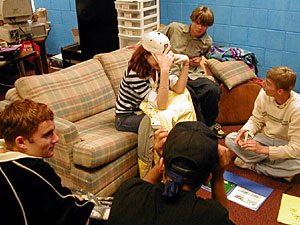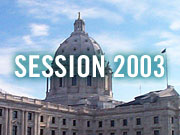Audio
Photos
Your Voice
| |||||||||||||||||||||||||||||||||||||||||||||||
Alternative schools fear state funding changes
May 6, 2003
 |
| A group of students discuss current events in a classroom at the South St. Paul Community Learning Center. (MPR Photo/Tim Pugmire) |
St. Paul, Minn. — Minnesota's complex education funding system pays school districts on a per-pupil basis, but not every pupil correlates with an actual student. A student enrolled in after-school remediation classes or summer school, for example, is worth 1.5 pupils in the funding formula.
Gov. Pawlenty and House Republicans want to keep the amount of money in the education formula at its current level for the next two years, but they also want to trim spending outside the regular classroom and regular school day.
Rep. Alice Seagren, R-Bloomington, chairwoman of the House Education Finance Committee, says the amount of money going to extra learning time has grown too large.
 | |||
"What they were doing were really saying I think that within the school day they couldn't get the job done," Seagren said. "And they were using this to create more programming or additional. It was really another way of getting more money, I mean it was really out of control."
A group of students discuss current events in a classroom at the South St. Paul Community Learning Center. There are 68 students enrolled in the center's day program. Another 50 attend after school sessions two days a week. More than 200 typically attend summer school here.
Alternative learning programs in Minnesota, like this one, served an estimated 170,000 students last year. Director Bill Zimniewicz says his high school students are considered to be at risk of dropping out.
"Everybody comes to this program with some blip on their academic record at school," Zimniewicz said.
 | |||
Zimniewicz and other educators are concerned students in area learning centers would be hardest hit by reductions in state funding for extra learning time. He says if the governor's cut was enacted, they could no longer afford to offer after school classes or summer school. Zimniewicz says the regular school day just isn't long enough for many students to get back on track.
"If somebody has dropped out of school or basically has failed school for two years in a row, 9th and 10th grade say, and now 11th grade they're an older wiser person." Zimniewicz said. "They still have, from a seat time perspective, they still have four years of school to do in two years. They've got a lot of make up to do." Amber Johnson moved to South St. Paul from North Dakota last year. She entered 9th grade at South St. Paul High School but had a hard time fitting in. Her grades suffered, and she dropped out of school. Johnson is now doing well at the area learning center, but she says she's three credits behind.
"I need summer school to get the other two credits." Johnson said. "So, I'm definitely looking forward to summer school. Because if I don't have summer school, it won't be nice. I'll be repeating the 9th grade."
Johnson says if she's forced to repeat a grade, she might leave school again. Jan Burley, a teacher at the South St. Paul Community Learning Center, says other students might make the same decision. She says students are in alternative programs because the traditional system failed them.
"They're here now, and they feel this is my place, this is where I can catch up and get a diploma," Burley said. "And if that's taken away, some of these students will be going here five, six years. And I personally wouldn't want to stay in high school for six years."
Under the governor's budget plan, one student would equal one pupil in funding calculations. House Republicans softened the cut by reducing the pupil weighting from 1.5 to 1.2, which provides some money for after school and summer programs, but not as much schools get now.
The DFL-controlled Senate is leaving the formula as is. Sen. Leroy Stumpf, DFL-Thief River Falls, chairman of the Senate Education Finance Committee, says the Legislature needs to live up to its current funding commitments.
|
News Headlines
|
Related Subjects
|

